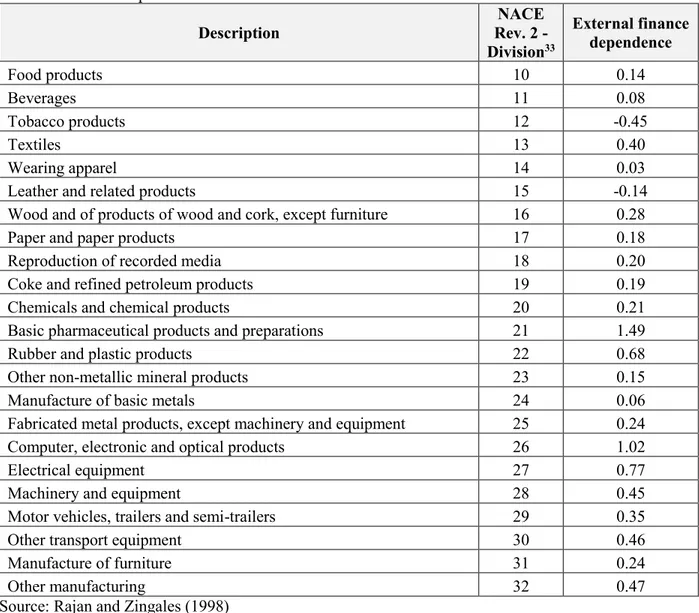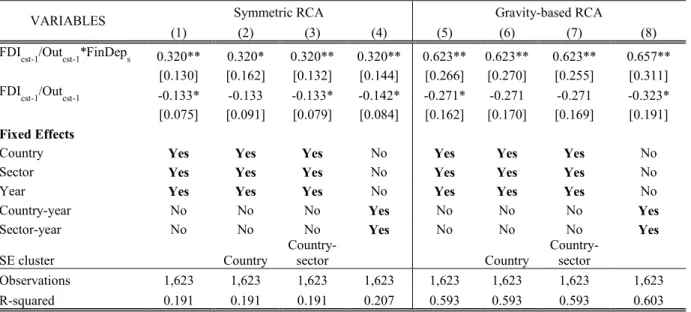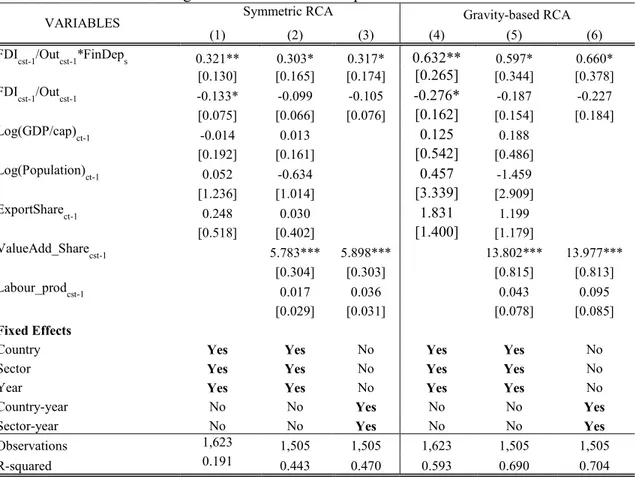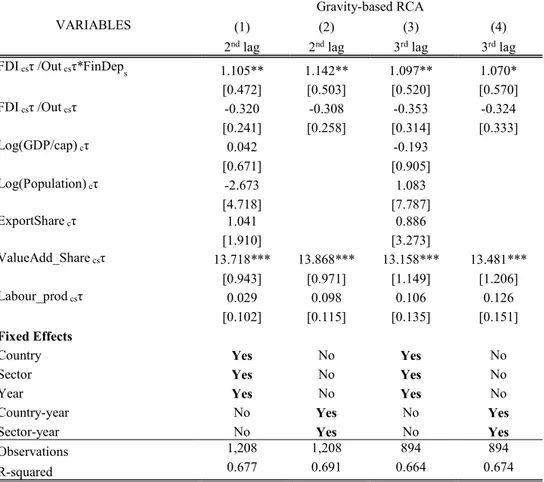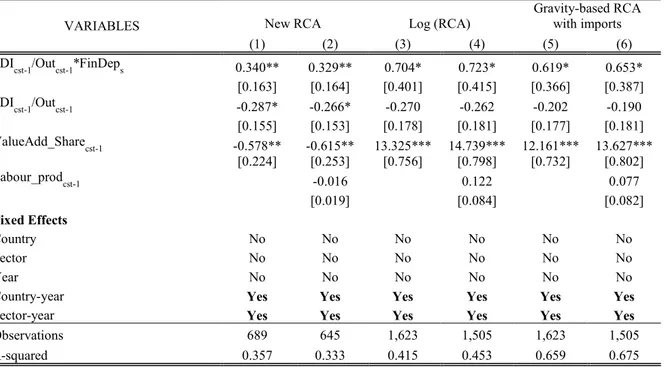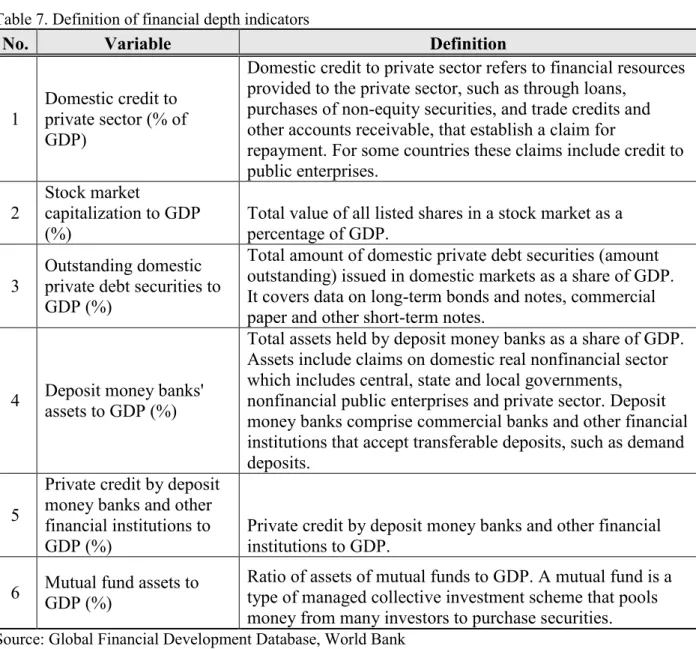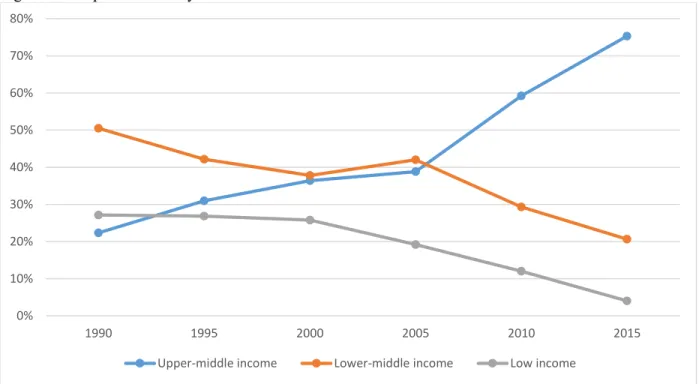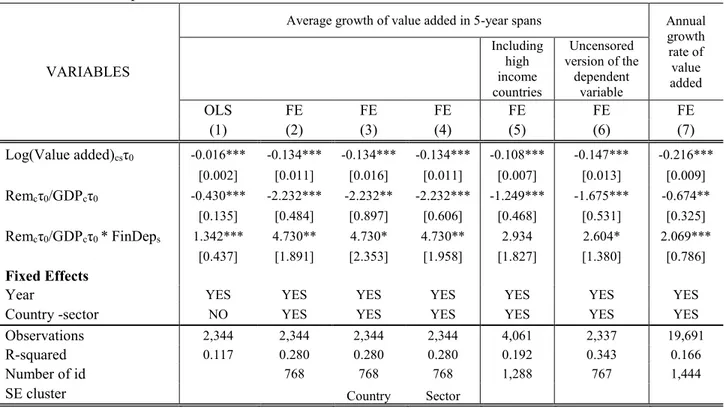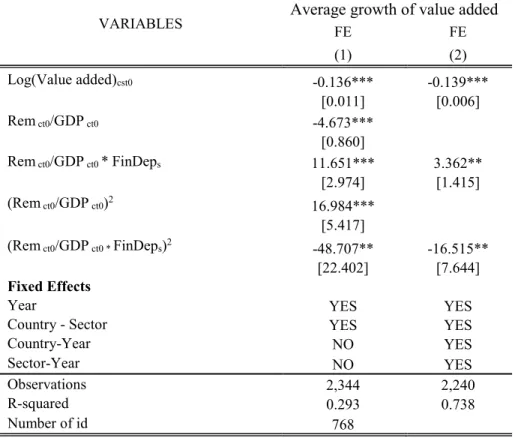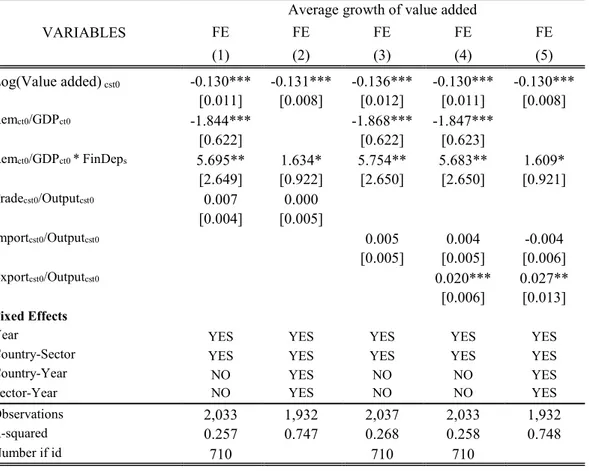UNIVERSITÀ POLITECNICA DELLE MARCHE
Dipartimento di Scienze Economiche e Sociali
PhD Thesis
International capital flows, comparative advantages and
manufacturing growth
Visar Vokrri
Supervisor:
Dr. Alessia Lo Turco
Associate Professor of Economics
2 Contents
1. Introduction ... 6
2. Literature review ... 10
2.1. FDI, specialization and comparative advantages ... 10
2.2. Remittances and growth ... 14
2.3. Financial dependence, trade and manufacturing industry ... 18
3. The role of FDI inflows in shaping comparative advantage patterns: an evidence from the OECD economies ... 24
3.1. Introduction ... 24
3.2. Data and measurement issues ... 26
3.3. Empirical approach ... 30
3.4. Results ... 32
3.5. Robustness checks ... 37
3.6. Final remarks ... 41
4. Impact of remittances on manufacturing growth. Are remittances a complementary source of external finance? ... 44
4.1. Introduction ... 44
4.2. Data and variables ... 46
4.3. Econometric estimation of the model ... 50
4.4. Results ... 53
4.4.1. Non-linearity ... 55
4.4.2. Trade effects... 56
4.4.3. Competing explanations: financial development, FDI and exchange rate appreciation ... 57
4.4.4. Controlling for country’s financial depth ... 59
4.4.5. Remittances in different country’s income categories ... 59
4.4.6. Interpreting the results ... 62
4.5. Final remarks ... 63
5. Conclusions ... 65
References ... 67
Appendix ... 75
A. Appendix to Chapter III ... 75
3
A.2. Definition of industry variables as per UNIDO – Industrial data user’s guide ... 76
A.3. Summary statistics for the FDI-comparative advantage model ... 77
A.4a. FDI and the industry financial dependence plot from the baseline specification ... 78
A.4b. Descriptive statistics of estimated sample in the baseline specification ... 78
A.5. FDI, comparative advantages and industry characteristics ... 79
A.6. FDI, comparative advantages and financial depth ... 80
A.7. Results from OLS regression in baseline specification – longer lags ... 81
A.8. Reverse causality test ... 82
B. Appendix to Chapter IV ... 83
B.1. Countries in all samples ranked by the level of income ... 83
B.2. Summary statistics of the variables in the remittance-manufacturing growth model .... 84
B.3. Estimates using uncensored (“unwinsorized”) dependent variable ... 86
B.4. Baseline specification of remittances with longer lags ... 87
B.5. Additional summary statistics ... 88
B.6a. Remittances and financial dependence plot from the baseline specification ... 89
4
Abstract
In this dissertation we provide a new evidence on the role of FDIs and remittances in manufacturing industries’ specialization and growth. More specifically, we explore a novel transmission mechanism through which the two largest sources of international financial flows might exert their growth-enhancing effect at the micro level. The channel that we explore is the role of FDIs and remittances as alternative sources of finance for financially dependent manufacturing industries. Using data for developed economies, we first estimate empirically the role of FDIs on comparative advantages and specialization. Then, we also examine the relationship between remittances and manufacturing growth in developing and underdeveloped countries. Our results show that FDIs are positively correlated with comparative advantages in financially dependent manufacturing industries. Similarly, we show that except the poverty alleviation effect, remittances matter for manufacturing growth, too. Our findings suggest a positive and statistically significant relationship between remittance inflows and manufacturing growth in financially dependent industries. Two important policy implications may be drawn from our analysis. Policies conducive to easing access and lowering the cost of finance as well as FDI promotion policies targeting more capital intensive industries, would have a positive impact on improving countries’ comparative advantages. Finally, channeling remittances towards investments – rather than consumption - in more capital intensive industries, may reduce the external finance gap.
5
6
1. Introduction
The recent decades have witnessed the most remarkable features of the world economy - globalization of economic activity, capital mobility and integration of financial markets, as well as increased global trade have been the driving force towards the global economic development and prosperity. Abolition of cross-country capital controls and financial markets liberalization have served as a major impulse for such unprecedented global developments. Cross-border financial flows’ growth across developed as well as developing economies has exceeded the growth of international trade and the global GDP.
The benefits of international capital flows in recipient economies were highlighted by a large amount of theoretical and empirical literature to date. Long-term economic benefits of international mobility of capital are unambiguous. Using the world savings, international capital mobility helps in financing the most productive investments and improve access to finance in scarce capital countries. In addition, it also fosters efficiency of domestic financial markets due to exposure to the foreign competition. However, the gains from international capital flows sometimes may be negligible due to several negative consequences such as potential effects on inflation, interest rates, as well as the susceptibility of the hosting economy to external shocks. Moreover, the determinants and the composition of capital flows also matter as different types of capital have different properties regarding the effects on the overall economic growth and prosperity. Thus, international capital movements may also carry potential (short-term) risks. That being said, the gains from international capital movements can be reaped only when preceded with adequate policy reforms aimed at minimizing the risk associated with capital flows.
Trade-offs associated with international capital flows and related concerns have attracted a plethora of both theoretical and empirical literature during the last few decades. However, the majority of the literature focuses on the relationship between the capital inflows and macro performance and almost consensually confirm the positive long-run effects. Here, in this dissertation, we contribute to the relevant literature with a new evidence on the international financial flows and its impact on development and growth. Specifically, our focus will be on the two largest external financial flows, namely foreign direct investments (FDI) and remittances, and their role on the manufacturing industries’ specialization and growth. Our emphasis on the above two sources of financial flows stems from two motives: first, FDIs and remittances remain a stable
7 source of finance for both developed and developing economies and exhibited an ever increasing trend during the last couple of decades; and second, considering the long-term positive effects of international financial mobility, there is a room for policy instruments as far as FDI and remittance inflows are concerned.
Our empirical analysis provides a new evidence on the role of FDIs and remittances in manufacturing industries. More specifically, we explore a novel transmission mechanism through which the two largest source of financial flows exert their growth-enhancing effect at the micro level. In other words, here we will analyze the role of FDIs and remittances as alternative sources of finance for financially dependent manufacturing industries. In order to examine if the “external source of finance” channel is at work, we first estimate empirically the impact of FDIs on comparative advantages and specialization - as evidenced by export flows - in developed economies, namely OECD member countries. The reason why we concentrate only on the OECD economies is three-fold: first, the largest share of the global FDIs is directed to developed countries; second, OECD economies account for three-quarters of the world trade, and lastly, there is lack of industry level FDI time series data for developing countries. In this part we will focus on the role of FDIs as a source of finance on comparative advantages by exploiting heterogeneous financial dependence across manufacturing industries. The underlying hypothesis is that foreign affiliates will bring capital as well as transfer the know-how and technology into host countries. Moreover, as the literature suggest, the presence of foreign firms have positive effects on recipient countries’ exports. Therefore, we expect a positive correlation between the FDI inflows and comparative advantages in industries that rely heavily on external finance.
Using a similar approach, next we investigate the impact of remittance inflows on manufacturing value added growth in manufacturing industries with different levels of dependence on external finance. Here the focus is on developing and underdeveloped economies as the largest share of global remittances is absorbed by these two categories. In relative terms, remittance inflows in some developing countries exceed twenty percent of their GDP. Assuming the altruistic motives of remitting and considering the countercyclical nature of remittances with respect to recipient economies, except to their role as hand-to-mouth transfer, remittances may serve also as “external source of finance” to more financially dependent industries in developing and underdeveloped
8 economies. As in the case of FDIs, we expect a strong positive correlation of remittances and growth in those industries that rely more on external finance.
To the best of our knowledge, the existing literature to date have not examined neither FDIs nor remittances as alternative sources of finance for financially dependent industries. Therefore, our work provides a modest contribution to different streams of the literature such as financial development and growth, FDI - host economies, and remittance and development literature. Results from our empirical analysis show that FDIs are positively correlated with manufacturing comparative advantages in financially dependent manufacturing industries. Similarly, using a large panel of low, lower-middle and upper-middle income countries, we show that except the poverty alleviation effect, remittances matter for manufacturing growth, too. In contrast to the Dutch disease theory, our findings convey the following message; there is a positive and statistically significant relationship between remittance inflows and manufacturing growth in financially dependent industries. Results in both empirical analysis are robust when controlling for different country as well as industry level indicators.
Finally, our findings have policy implications and suggest that policies conducive to easing access and lowering the cost of finance as well as FDI promotion in more capital intensive manufacturing industries (i.e. those in more need for external finance) would improve country’s comparative advantages. A second important implication deriving from our empirical work suggest that policies to channel remittances towards investments (rather than consumption) in more capital intensive manufacturing industries, may reduce the external finance gap.
The rest of the dissertation is organized as follows. The second chapter provide an analysis of the literature related to FDI, remittances and financial dependence. The next two chapters investigate empirically the FDI-comparative advantage link and the role of remittances on manufacturing growth, respectively. The last part concludes.
9
10
2. Literature review
In this part we provide a thorough analysis of the relevant literature which consist of three different fields. The first section focuses on the literature related to FDI and its role in the host economies from a micro perspective. Then, we cover the remittance-growth literature from with a special emphasis on the home countries perspective. Lastly, we provide an analysis of the literature on the financial sector and micro agents with a particular emphasis on the financial dependence of manufacturing industries.
2.1. FDI, specialization and comparative advantages
The existing literature on this topic encompasses different streams. First, we narrowly cover both theoretical and empirical work related to international trade patterns and specialization. Then, we focus on FDI literature, primarily on the determinants of FDI and the impact of foreign firms’ presence in host countries.
According to traditional trade theories, trade between countries occurs due to the differences in existing comparative advantages. Countries specialize only in those goods or services which can be produced at the lowest opportunity cost. Nevertheless, the theory of comparative advantages has been one of the most debated concept in international trade theory and it has attracted a lot of attention and empirical work to date. Ricardian model and its subsequent extensions have been the workhorse of a vast empirical literature over the last couple of decades.1 However, the data shows that trade also take place between similar countries in terms of factor endowments. This inconsistency led to the new trade theories which recognize also other potential sources of trade such as economies of scale, technological know-how, etc. The emergence of the new theories triggered a vast amount of empirical work aimed at assessing the role of new determinants in international trade patterns. While country’s endowments (i.e. physical and human capital) play an important role, they do not solely determine what a country can be good at. Hausmann et al. (2007) demonstrate theoretically the differences in the specialization patterns of similar countries. They highlight the importance of complementary elements in specialization patterns with
1 Recently, Alviarez (2018) shows that Ricardian comparative advantage is relevant in determining the aggregate level and the sectoral allocation of multinational production and trade.
11 empirical support for their model and show that the exporting goods associated with higher productivity levels grow faster. Differences in efficiencies across firms also determine the aggregate trade flows (Eaton et al., 2011). By studying the network of relatedness between products, Hidalgo et al. (2007) show that countries change specialization patterns over time. According to them, the most qualitative and complex products are located in a densely connected areas while lower income products - are located in less connected periphery. In order to upgrade their export structure more quickly, countries tend to specialize in goods close to those they are currently specialized in (“nearby” goods).
Further, Proudman and Redding (2000) provide an evidence of large mobility in terms of international specialization patterns. In other words, they show that instead of having a systematic increase of (revealed) comparative advantages in particular industries, they remain almost unchanged over time.
Geography, among others, is also being considered as an indicator through which trade influence income and growth. Frankel and Romer (1999) investigate the impact of international trade on standards of living (measured by country’s income per capita) using geographic characteristics as instruments to identify the direction of causation. Nevertheless, they suggest that geography provide limited amount of information about the trade-income nexus. The fact that geography has a role in economic activity has been broadly supported. The literature on the gravity model of international trade has validated that geography is a significant component of trade.2
The role of technology also been stressed as a strong determinant of specialization since countries’ productivity levels vary across industries. Eaton and Kortum (2002) highlight the importance of geography and technology using data on bilateral trade flows and examine how these two different features jointly determine the patterns of specialization.3
Another strand of literature that identify and categorize the sources of comparative advantages that countries have. Theoretical contribution of Costinot (2009) highlights the importance of the quality of labor as well as institutions as the main sources of comparative advantages in more complex
2 See for example Frankel et al. (1995), Frankel (1997);
3Similarly, international trade data is used in a multi-sector framework by Levchenko and Zhang (2016) to examine
12 industries. Extending the model of Eaton and Kortum (2002) to explain trade flows, Chor (2010) consider comparative advantages as a function of both institutions and industry characteristics. In this model countries specialize in industries in which production needs can be meet at best. The role of institutions is also emphasized by Costinot et al. (2015) where they attempt providing an answer to what is the optimal trade policy with respect to comparative advantages. The paper suggest that uniform trade taxation across imported products and weakly decreasing subsidies in comparative advantages sectors would maximize the overall domestic welfare.
An important branch of literature that we consider in this paper is also the relationship between foreign direct investments and growth. Much of the existing literature emphasize the relationship between FDI and aggregate performance or seek to identify the determinants of FDI flows (mainly) from the recipient countries’ perspective. The traditional determinants such as skilled workforce, low labor costs, market potential in recipient country, etc., have been identified as the most common determinants attracting the FDI flows. Apart from the above factors, method of privatization and other transition specific aspects play important role in determining the flows of FDI (Carstensen and Toubal, 2004). The role of institutions has also been acknowledged when it comes to attraction of FDI. There is a new stream of the literature that focuses on the determinants of FDI inflows, with a special emphasis on institutions. Trade openness, political rights, economic freedom and even EU membership, have a positive and substantial role on FDI inflows, argues Tintin (2013). Harding and Javorcik (2011) examine the effects of investment promotion efforts on actual inflows of the U.S.’ FDIs. Their findings suggest that investment promotion leads to higher FDI inflows mainly in developing countries. Assuming that there is a room for policy makers in changing the directions of country’s trade patterns, in a very recent empirical analysis, using a panel data for 73 low and medium income countries for a 25 year period, Harding et al. (2016) estimate the relationship between FDI promotion practices and country’s export structure. They show that promotion activities as a tool for attracting foreign multinationals contributed to increasing countries’ comparative advantage position as measured by the Balassa RCA.
Direction of causation (one or possibly two-way causality) remain the most challenging part in the literature involving FDI and aggregate components such as GDP or even local level indicators such as infrastructure. In an attempt to shed some light on causality issue, Chan et al. (2014) indicate that the GDP growth directly influences FDI inflows, in both the short and over the long
13 run. There is a large amount of literature, albeit new, that analyses the role of FDI in host countries via different channels whether at country level or firm level data. The literature on the existence of spillovers of FDI inflows associated with the entry of foreign affiliates is somewhat divisive. At the firm level, positive spillovers are usually defined as any kind of productivity increase, improved access to international markets, the emergence of high-tech products or even development of new products. Rodrik (1999) pointed out that claims about positive spillovers from FDI are barely supported by empirical evidence. In one hand, a large amount of literature finds a positive correlation between the presence of foreign firms and the overall productivity of local firms in host countries (Karpaty and Kneller, 2011; Greenaway et al 2004; etc.).4 On the other hand, another stream of literature finds no association or to some extent negative impact of the foreign capital in domestically owned firms (Konings, 2001; Aitken and Harrison, 1999). However, most of the relevant literature have provided evidence on the existence of positive spillovers.
Javorcik (2004) confirms the presence of spillovers from FDI across industries through backward linkages i.e. contacts between foreign firms and their domestic suppliers. Yet, she finds no evidence of spillovers taking place through horizontal and forward linkages.5 Apparently, an underexplored channel for productivity spillovers is via exports. But, does the increase of exports associated with FDI inflows improves the productivity level of local firms? Empirical trade literature has already established that exporters are more productive than non-exporters. So, if the presence of foreign firms results in more domestic firms exporting, an indirect productivity spillover will result. Based on this premise, Greenaway et al. (2004) have investigated productivity spillovers from the presence of MNEs via exports. Results from this paper confirm export spillovers from MNEs in UK-owned firms.
The export channel seems to have a strong explanatory power on the impact of FDIs on overall growth. Moreover, it is commonly acknowledged fact that the export matter for growth.6 In fact,
4 Additionally, using firm level data for Chinese manufacturing firms, Buckley et al. (2002) finds technological and international market access spillover benefits from MNEs.
5 Horizontal linkage is the contact between the local firms and foreign affiliates in the same industry, while forward linkage channel implies cooperation between local firms and multinational suppliers.
6 Causality between export growth and industrial development (Chow, 1987); Agricultural exports and its effect on country’s economic growth (Dawson, 2005).
14 it is the qualitative composition of exports that fosters growth more; exports of more complex goods are positively correlated with growth. Supposing that upgrading the structure of exports is high on the policy agenda, especially in developing economies, Harding and Javorcik (2012) estimate the effect of FDI promotion on quality of exports. They argue that sectors prioritized in promotion efforts export more sophisticated products than other sectors.
Finally, there is also a plenty of anecdotal evidence on the positive spillovers associated with FDI. A large number of foreign affiliates in Western Balkans have contributed to better exploitation of existing comparative advantages and export growth. Manufacturing sectors and recently services, were the main target of foreign investors in this region.
2.2. Remittances and growth
Migrants and their role in both host and home countries has been immensely studied to date and it was one of the most popular topics in the development literature. Information and networks were considered as the main channels through which migrants promote their home country’s economic welfare, mainly due to their importance in overcoming informal barriers to trade. Bilateral trade between the home and host country is found to be positively correlated with immigration (Head and Ries, 1998). Moreover, Rauch and Trindade (2002) examine the impact of Chinese networks on bilateral trade and show that business and social networks have substantial quantitative impact on trade flows. However, networks and links with their home countries, are not the only channels through which migrants exert their benefits. Migrant remittances constitute an increasingly important mechanism for the transfer of capital and have become a major source of financial flows for underdeveloped as well as developing economies. Nevertheless, the main reasons of remitting center on the family, primarily for consumption purposes. Therefore, most of the literature to date internalize this fact when examine the impact of remittances in home countries. The evidence is mixed; while there is a strand of literature that confirm the positive role of remittances on the overall socio-economic prosperity, some argue that the effects of remittances - mainly based on the Dutch disease theory - are contractionary.
15 The channels through which the adverse effect of remittances is transmitted are quite similar to those of the foreign aid.7 A very recent study by Bahadir et al. (2018) using an innovative approach, namely Dynamic Stochastic General Equilibrium (DSGE) model, study remittance inflows at the macroeconomic level and show that depending on the final use, remittances may exert contractionary or expansionary effects. When remittance flows are compensatory transfers their response tend to have a negative effect on economic activity while the opposite occur once remittances accrue to credit-constrained entrepreneurs. The fact that remittances promote the growth of non-tradables at the expense of tradable sectors is well known in the literature. Estimating a two-sector DSGE model to examine the role of remittances on emerging economies, Acosta et al. (2009) finds that any increase in remittance inflows leads to a decline in labor supply as well as increase in demand for consumption of non-tradables.
There are many other studies – in line with these findings – which show that remittances are not growth enhancing. Le (2009) investigates jointly the role of trade, remittances and institutions in economic development. His results confirm the positive impact of institutions and trade - albeit the role of the latter is found to be ambiguous - but a negative effect of remittances on growth. Similarly, Gapen et al. (2009) finds, at best, no positive impact on economic growth from remittances.
There is another narrow stream of recent empirical literature that digs further and question any positive role and even consider remittances as a curse. Some argue that the negative externalities offset any kind of short-run positive effects and actually pose serious development challenges. According to Chami et al. (2005), remittances are not profit driven but rather compensatory transfers. As such, they are negatively correlated with economic growth. Regardless of their nature as hand-to-mouth type of transfers, remittance inflows may have adverse effects on institutional quality of recipient countries – that are similar to those of large natural resources flows. Corruption is one of the main channels through which remittances have a negative impact on institutions as it will become less costly for domestic beneficiaries to bear, argue Abdih et al. (2012).8
However, one cannot ignore the positives of remittances, especially their impact on alleviating poverty in underdeveloped as well as developing economies. It is commonly held view that
7 See Rajan and Subramanian (2008; 2011) for the empirical literature on aid.
16 remittance inflows reduce the level and severity of poverty in domestic countries; there is plentiful empirical research that examine their poverty-mitigating effect. Stable remittances in the form of private transfer have a direct impact on poverty reduction as well as promotion of financial development (Adams and Page, 2005; Gupta et al., 2009). Furthermore, Lim and Basnet (2017) try to isolate the impact of remittances on per capita income within the permanent income hypothesis framework.9 They show that remittances from short-term migrant workers have positive impact on income.
Financial development in developing countries is positively correlated with remittances while in low-income economies the relationship is not clear (Fromentin, 2017; Cooray, 2012).10 The level of financial development has been closely analyzed along remittances also due to their potential synergistic effect that may jointly have on economic growth. Mundaca (2009) developed a theoretical framework and tested empirically interrelationship between financial market development and remittances. She finds, among other things, that if channeled through sound financial intermediaries and used for capital investments, remittances have a large and sustained positive effect on the economy. Rather than working as substitutes, remittances complements financial system and its growth-enhancing role in the economy (Bettin and Zazzaro, 2012). Potential endogeneity is a common issue when assessing the impact on remittances on aggregate indicators. Different approaches have been used in order to deal with weaknesses arising from endogeneity and reverse causality problems. Using a micro-econometric model of the migrant-household behavior, Bettin et al. (2012b) somewhat confirm some of the above findings; financial development is likely to affect positively immigrant’s trust on financial institutions.11 In other words, the amount of transfer is positively correlated with the level of financial development in
9 Permanent income hypothesis theory is developed by Friedman (1957) and states that permanent increase in income raises consumption - at a level consistent with expected long term income, while transitory income is saved and invested.
10Similarly, using aggregate variables, Aggarwal et al. (2011) finds positive and significant association between
remittance inflows and financial sector development proxies, namely ratio of bank deposits and credit to GDP. Moreover, Giuliano and Ruiz-Arranz (2009) show that the impact of remittances is higher in shallower financial systems, namely less developed financial markets. They also indicate that remittances appear to be pro-cyclical. In addition, their findings also suggest that there is an investment channel through which remittances exert its impact on growth.
11 Bettin et al. (2012a) in another model of remittances deal with the endogeneity and reverse causality issues by estimating IV of double-hurdle and Heckit selection models using Limited Information Maximum Likelihood (LIML) technique.
17 the country of origin; however, they show that the propensity to remit is not affected by financial development.
Motivations and determinants of remittances have also been vastly explored both theoretically and empirically. As far as motivations are concerned, there are two main “competing” theories on remittances, namely altruism and risk sharing (co-insurance motives). The former refers to the hand-to-mouth transfers sent to households with low levels of welfare whereas the latter consist mainly on profit driven investments. Even though there is no consensus on migrants’ remitting motives, altruistic incentives prevail in the literature (Agarwal and Horowitz, 2002; Lucas and Stark, 1985). Implicit loan contract is another theory that attempts to explain remitting behaviors. The basic idea of this theory is that families function as an “informal market” where migrants finance non-migrant members’ investments in human or physical capital (Poirine, 1997; Adams and Cuecuecha, 2010).12 Field experiments have also been employed to better understand remitting behaviors (Torero and Viceisza, 2015).
Remittances, albeit in rare cases, have been recently studied also from the migrants’ host countries perspective. In this context, Olney (2015) seek to shed light on their potential contractionary effects in the host economies through the demand channel. More specifically, he finds that remittance outflows depress wages of native workers as the consumer base will shrink and that the effect is more prevalent in non-tradeable industries that rely more on domestic consumption. Some attempts have been made also in exploring the effect of remittances on industrial growth with a special emphasis on exports. In contrast to Dutch disease theory, Fayad (2011) finds that remittances contribute to the growth of manufacturing industries via exports as the main transmission channel.13
Most of the literature on remittances take into consideration only specific aspects at a certain period while ignoring their overall long-run effects. Due to the contradictory nature of the empirical evidence, a more heuristic approach may provide a clearer and thorough overview of the real
12 Bansak and Chezum (2009) study also the relationship between emigration, remittances and the educational attainment of migrant’s children in the home country.
13In order to correct for endogeneity, Fayad (2011) uses different set of instruments – based on economic determinants
of remittances (interest rate differentials, growth rate in host countries) as well as non-economic determinants of migration (i.e. geographical distance).
18 effects of remittances. Gaps on the remittances literature have been identified more than three decades ago by Russell (1986) where he argues that an alternative, comprehensive and much more systemic approach is needed in order to better clarify relationships between determinants and effects of remittances.
2.3. Financial dependence, trade and manufacturing industry
Finance and its importance were subject to many theoretical and empirical contributions during the last century even though there are opposing views as far as the finance-growth relationship is concerned. In one hand, the positive role of the financial system was highlighted more than a century ago; Schumpeter (1911) was one of the first to emphasize the positive role of the financial sector on the growth rate.14 He argued that a well-functioning financial system spurs the supply side which in turn exerts its growth enhancing effect in the economy. On the other hand, Robinson (1952) argued that the financial system follows the growth of businesses; in other words, it is the economic activity that creates demand for financial services and as a result develop the financial sector. Except the above conflicting views, there are also other streams among economists that either believe that finance-growth nexus is irrelevant and the role of finance is over-stressed (Lucas, 1988) or completely ignore the role of finance because of their skeptical views about any kind of positive impact stemming from the financial development (Chandavarkar, 1992). However, the recent literature tends to acknowledge more the positives of financial development. The importance of financial health and stability has been noted especially after the last financial crisis. Today’s literature evidently highlights the ever increasing importance of the stability of financial system and its role as one of the main pillars in the functioning of market economies. Moreover, it has also been stressed that the existing research, both theoretical and empirical, except that have policy implications, is also quite important for shaping the future policy-oriented research (Levine, 2005). Nevertheless, the focus of the literature is shifting towards the study of financial determinants.15
In countries with developed financial system, firms benefit through an eased access from multiple sources of finance for their investments. The level of financial development is linked with the
14 Such views were also supported, among others, by Gurley and Shaw (1955) and Shaw (1973)
15 Some of the determinants that have been considered so far include, but are not limited to, legal system (La Porta et al., 1997 and 1998), remittances (Aggarwal et al., 2011), trade (Rajan and Zingales, 2003; Law, 2009), etc.
19 overall countries’ economic development; high-income countries have the most developed financial markets.16 As we have shown in the previous sub-section, there is an extensive literature - both theoretical and empirical - on the role that financial sector plays in nurturing economic development and growth. Financial sector development has been considered by many as the main driver of the economic prosperity and growth (Henderson et al., 2013; Levine, 1997; etc.). However, most of the literature is focused on the direct link between the performance of the financial markets and macro level indicators (i.e. GDP per capita). To our knowledge, channels through which financial sector fosters private sector development have not been sufficiently exploited. In this context, our main interest is on the impact of international capital flows in financially dependent manufacturing industries in both financially developed and less-developed economies.
Financial development has also been considered as one of the main drivers, as the theory suggests, of international trade patterns. A great contribution on the financial markets and international trade theory is given by the work of Kletzer and Bardhan (1987). Extending the Heckscher-Ohlin model by incorporating a financial sector, they demonstrate that financial development play an important role in trade flows; credit market imperfections lead to differences in comparative advantages even between countries with identical technologies and endowments. Nevertheless, it is not a one-way link; trade integration could also increase capital inflows in economies with less developed financial markets. From a financial frictions perspective, in contrast to the classical model of Heckscher-Ohlin-Mundell which consider trade and capital flows as substitutes in capital scarce countries, a new theoretical contribution by Antras and Caballero (2009) provides a different conclusion. In less financially developed countries, trade and capital flows are complements. The return to capital is increased through trade, hence more incentives for capital to flow in such countries.
Baldwin (1989) has also linked financial markets with countries’ comparative advantages. In his model, in financially developed economies, firms that produce goods subject to demand shocks face lower marginal costs compared to firms in countries with less-developed financial markets. However, the work by Kletzer and Bardhan (1987) remain a solid framework for empirical analysis
16 The domestic credit provided by financial sector as a share of GDP is higher in developed economies (World Bank, World Development Indicators, 2018)
20 that seek to shed light on the importance of financial systems in shaping international trade patterns.
There are several channels through which financial development affects the industrial structure of exports and comparative advantages. A more recent literature that provides new evidence on this issue is the work by Beck (2002). Financial sector’s role in channeling savings to firms is the focus of his work. He explores both theoretically and empirically cross-country differences in terms of financial development and its role on the international trade patterns. His theoretical model proves that in countries with better financial systems, sectors with high scale economies profits more. These countries are net exporters of the goods being produced in such sectors and therefore have comparative advantages in the same sectors. Using a 30-year panel with 65 countries, he estimates empirically and further support predictions of his model. Results confirm the above; economies with better developed financial markets have much higher share of exports (manufactures) to GDP as well as higher trade balance in manufactured goods.
One of the most influential work examining the performance of industrial sectors and the link with financial markets is the paper “Financial Dependence and Growth” by Rajan and Zingales published in 1998 (hereafter “RZ”). More specifically, they examine whether industrial sectors that are more dependent on external finance develop faster in countries with more developed financial markets. RZ use financial data on the U.S. firms to measure the dependence level on external finance.17 It should be noted that the financial dependence index developed by RZ is being used (also) in today’s literature as a benchmark for demand for external funds in industrial sectors. According to RZ, financial development has a supportive role on the rate of economic growth. This can be explained, partly, by the cost reduction of external finance to highly financially dependent firms. Using a large sample of 41 countries during the 1980s, RZ show that there is a positive correlation between the level of financial sector development and the growth pace of highly financially dependent sectors. Following RZ’s contribution, a new stream of empirical literature emerged; financial dependence has been widely employed as an indicator to examine the effect of financial development on trade and capital flows in firms that are highly dependent on external finance. Using RZ financial dependence index, Beck (2003) finds that in countries that enjoy higher level of financial development, industries that rely more on external finance have
21 higher export shares. Lo Turco et al. (2018) further extend the RZ empirical model by incorporating also upstream and downstream sectors’ financial dependence level. Specifically, they investigate a new indirect channel through which financial development fosters industry growth: Input-Output (IO) linkages between sectors. Their results suggest that the financial development effect is propagated through IO relations; financial market development affects more those industries that are connected by IO links to financially dependent upstream industries. Another recent contribution by Alquist et al. (2018) provide a new evidence on the impact of dependence on external finance and the decision of foreign firms to invest in host countries. They show that foreign firms are more likely to fully acquire a local firm in sectors that rely more on external finance or countries with low level of financial sector development.18 On the other hand, partial acquisitions seem to be less dependent on financial factors. Along the same lines, Manova et al. (2015) provide new micro level evidence on the financial imperfections and international trade patterns. Using Chinese firm-level data they confirm the importance of foreign affiliates in overcoming credit frictions effects. In financially constrained sectors in China, joint ventures and foreign subsidiaries export much more than local. A novel contribution by Antras et al. (2009) demonstrates theoretically and empirically the mechanism generating multi-national corporate activity in foreign markets. External funders, namely financial institutions, have stronger preferences and are more willing to finance projects involving a multi-national firm as the latter have strong incentives to monitor project implementation and therefore ensure that local partners are pursuing value maximization.
Vulnerability of financially dependent firms can be analyzed better during the financial shocks. The last global financial crisis has been extensively analyzed for almost a decade now to confirm well-established predictions on the impact of financial shocks on economic outcomes. The “Great Recession” have had lasting repercussions also on cross-border economic activities. According to the World Trade Organization (WTO), due to the downfall in global demand following the crisis, exports fell by 12% in 2009. Eaton et al. (2016) develop a model to investigate the contribution of different country-specific shocks during the 2008-2009 financial crisis on trade. They argue that
18 Similarly, Desbordes and Wei (2014) investigate home and destination countries’ financial development level and
its impact on FDI through direct increase of access to external finance. They show that financial development have a positive impact on greenfield investments, business expansion, as well as mergers and acquisitions.
22 investment efficiency shocks shift the final consumption away from tradable goods.19 In order quantify the effect that credit conditions had on international trade during the first years of the crisis, Chor and Manova (2012) use data on U.S. imports and interbank interest rates in countries exporting to the U.S. They basically examine how credit constraints affected trade flows across exporting countries. Results from this empirical work indicate that countries with higher interbank interest rates exported less to the U.S. Additionally, they exploit also variations across sectors and show that the effect is more prominent in financially vulnerable sectors (i.e. sectors that need more external financing). The fact that exports are affected by financial – both internal and external – factors, is also supported by earlier firm level empirical analysis. From a slightly different perspective Amiti and Weinstein (2011) establishes a causal link between the health of banks and exports. Their findings suggest that exports as opposed to domestic sales, are more sensitive to financial shocks. Using data from UK manufacturing firms, Greenaway et al. (2007) show that better financial health is found among (continuous) exporters as opposed to non-exporters. Such findings indicate that reducing the level of financial constraints faced by firms could increase the productivity and the level of exports.
Lastly, using detailed micro level data on Italian manufacturing firms, Minneti and Zhu (2011) find that credit rationing negatively affects the propensity to export.20 Firms having difficulties in getting credits are less likely to export compared to those being able to obtain credits for their investments. When quantifying the results, they show that probability of exporting is nearly 40% lower for rationed firms and that the negative effect of credit rationing on exports is larger than domestic sales. Credit constraints have been proved to be an important factor of trade flows across countries also in Manova (2008) and Manova (2012). Also Muûls (2015) confirm that credit constraints affect both imports and exports. Less-constrained firms have higher probability of both exporting and importing. When it comes to exports, both intensive and extensive margins are positively associated with credit constraints in terms of products and new destinations, while with imports it the extensive margin of products (i.e. new imported products) that is affected more.
19 Using a dynamic multisector general equilibrium model of international trade, Eaton et al. (2016) assess the contribution of different types of shocks, namely technology, preferences, and endowments, to the collapse of trade. 20 Authors use two different measures for credit rationing. Strong credit rationing is being considered if (i) the firm
would have liked to obtain more credit at the market interest rates in the previous year (i.e. 2000), and (ii) the firm obtained less credit than actually requested. When (i) applies only, credit rationing is labeled as a “weak”.
23
24
3. The role of FDI inflows in shaping comparative advantage
patterns: an evidence from the OECD economies
3.1. Introduction
Today, policymakers around the globe, especially in developing countries, strive to exploit policy tools to improve the export structure and shape the pattern of specialization and trade. The role of exports in economic development is crucial. Based on the export-led growth hypothesis, one of the main drivers of economic growth and prosperity is growth of exports. At the same time, there is a strong competition in terms of policy making as far as attraction of foreign investments are concerned. Foreign Direct Investments (FDI) are being considered as an important source of development, particularly in emerging economies; most of these countries rely heavily on FDI to address economic imbalances. According to the official data, it is estimated that the value of global FDIs in 2017 was 1.52 trillion US dollars where 43% were directed into developing economies.21 Moreover, it is commonly acknowledged fact that the presence of foreign affiliates will bring capital, new jobs and also transfer technology and know-how into host countries.
The existing literature on FDI and exports suggest that the presence of foreign firms have positive effects on host countries’ exports, ultimately leading to improved or new comparative advantages.22 Nevertheless, the focus of the recent literature was mainly on other sources of comparative advantages i.e. differences in productivity, institutional sources, and other potential factors that might foster the emergence of new comparative advantages. Financial development has also been considered an important factor for improving countries export structure as well as a precondition for FDI’s positive impact on the overall growth (Hermes and Lensink, 2003). In this paper we argue that FDI can also play an important role as a financial source in manufacturing sectors, especially highly capital intensive ones that rely more on external finance. To our knowledge, there is a lack of literature that examine financial development as the main channel through which FDI exert its positive impact on exports and industry comparative advantages. We fill this gap using the FDI inflow data disaggregated at the industry level in a panel
21 Investment Trend Monitor, UNCTAD (2018) available at http://unctad.org/en/PublicationsLibrary/diaeia2018d1_en.pdf
25 for 31 developed economies covering a time span from 2007 to 2016 with a special focus on manufacturing industries, only. Although the data on FDI are gathered from different countries, the same data collection and processing methodology has been applied. Balassa index, namely revealed comparative advantages (RCA), has been constructed using the product level export data for the whole sample which we have extracted from Comtrade database. However, as proposed by French (2017) we construct a gravity based index as an alternative measure to the Balassa index which is used as an industry comparative advantage indicator.
Our results suggest that there is a positive relationship between FDI inflows and the comparative advantages in financially dependent sectors. Results are consistent to different set of fixed effects as well as different specifications and robustness tests.
Finally, the main findings of this paper suggest that there is also room for policy interventions. Investment promotion policy with a focus on manufacturing sectors that rely more on external finance would improve manufacturing comparative advantages. In addition, financial policies aiming at lowering the cost of external finance as well as easing access to finance for manufacturing sectors might have a positive impact on comparative advantages, too.
This chapter is organized as follows. Data description and sources is included in the next section. Section 3.3 describes the empirical approach that have been employed in this paper. Section 3.4 and 3.5 presents the main results and robustness tests respectively. The last section concludes.
26
3.2. Data and measurement issues
In this paper we make use of different data at different levels of aggregation (i.e. country, industry as well as product level data). In our empirical analysis, we focus on the manufacturing industries for 31 high income economies, namely OECD countries for which we have FDI disaggregated data at industry level.23 24 A full list of the countries included in our analysis is reported in the Appendix A.1. The trade data, namely export flows, at 6 digit HS 2007 product level for the period 2007-2016 were collected from the Comtrade database through World Integrated Trade Solution platform.25 We use export flow data in order to construct our dependent variable, namely the revealed comparative advantage (RCA) index as introduced by Balassa (1965). The index is defined as the ratio of a country’s exports in particular product to its total exports divided by the world’s share of the same product to total world’s exports:
𝑅𝐶𝐴𝑐𝑝𝑡 = 𝑋𝑐𝑝𝑡/𝑋𝑐𝑡
𝑋𝑝𝑡𝑊/𝑋𝑡𝑊 (1) where 𝑋𝑐𝑝𝑡 and 𝑋𝑐𝑡 represent the exports value of product p at time t in country c and total country c’s total exports, respectively; 𝑋𝑝𝑡𝑊 and 𝑋
𝑡𝑊denote the world’s exports of product p at time t, respectively world’s total exports at time t. However, as proposed by Laursen (2015), we use the following adjusted symmetric version of the RCA index in order to deal with the skewness of the Balassa version of RCA.26
SymRCAcpt =
RCAcpt−1
RCAcpt+1 (2)
At the industry level, we use data at 2-digit NACE Rev. 2 on FDI inflows, and other industry size indicators such as output, value added, and the number of employees. Data on FDI inflows for all OECD countries were obtained from the OECD statistics database.27 In order to ensure the data
23 Two countries (Canada and Switzerland) were excluded due to the lack of data while Luxembourg was not incorporated since it is more a service oriented economy.
24 The reason why we focus on the OECD economies is three-fold: first, the largest share of the global FDIs is directed to developed countries; second, OECD economies account for three-quarters of the world trade, and lastly, there is lack of industry level FDI time series data for developing countries.
25
http://wits.worldbank.org/WITS/WITS/AdvanceQuery/RawTradeData/QueryDefinition.aspx?Page=RawTradeData 26 For robustness purposes, several additional definitions of RCA will be used.
27 quality and accuracy, FDI data have been collected, where available, also from relevant institutions in OECD economies (i.e. central banks). Data collection of FDIs in OECD economies is consistent with the IMF Balance of Payments Manual 6th Edition (BPM6) for FDI data collection and processing.28 It should be noted that negative flows are defined as reverse investments or disinvestments and this classification apply across the whole sample.
The main explanatory variable in our model is the value of FDI inflows in respective manufacturing industries. However, for comparative purposes, we have normalized the FDI inflows by dividing them with an industry size indicator, namely the industry output. All industry size variables are extracted from UNIDO – Industrial Statistics Database (INDSTAT 2).29 It should be noted that FDI data for the OECD sample as well as UNIDO industry size indicators were available at ISIC Revision 3 and Revision 4 respectively. However, such data were converted into corresponding 2-digit respective codes at NACE Revision 2 level using official UNSTAT correspondence tables.3031
As we consider FDIs as complementary source of finance, our main explanatory variable will be an interaction of FDI inflows normalized by the industry output and the financial dependence on external finance of that particular industry. This interaction allows to capture differences on the effect of FDI inflows in industries with different financial dependency levels. The data on financial dependence on external sources is obtained from Rajan and Zingales (1989).32 The firm’s dependence in external finance is computed at the firm level using a large U.S. dataset and is defined as follows:
𝐷𝑒𝑝𝑒𝑛𝑑𝑒𝑛𝑐𝑒 𝑜𝑛 𝑒𝑥𝑡𝑒𝑟𝑛𝑎𝑙 𝑓𝑖𝑛𝑎𝑛𝑐𝑒 =Capital expenditures – Cash flow from operationsCapital expenditures (3) To summarize the dependency level across firms in the same industry, RZ use industry median, rather than other central tendency measures, in order to eradicate the effect of outliers in the data. Using the RZ financial dependence index in our model implicates the following assumptions. First,
28 IMF’s Balance of Payments and International Investment Position Manual is available at https://www.imf.org/external/pubs/ft/bop/2007/pdf/bpm6.pdf.
29https://www.unido.org/researchers/statistical-databases 30https://unstats.un.org/unsd/cr/registry/regot.asp?Lg=1
31 Detailed description of UNIDO industry variables is provided in Appendix A.2.
32RZ index has been extensively used in the finance-growth literature (see for instance Beck and Levine, 2002;
28 assuming that the U.S. financial markets are frictionless, firms in the U.S. should not face financial constraints. Therefore, the actual demand for external finance of the U.S. firms’ reflects the real dependence on external sources for capital expenditures. In addition we also assume that the (technological) needs of external finance are common across countries in the same industries.
Table 1. Financial dependence index
Description NACE Rev. 2 - Division33 External finance dependence Food products 10 0.14 Beverages 11 0.08 Tobacco products 12 -0.45 Textiles 13 0.40 Wearing apparel 14 0.03
Leather and related products 15 -0.14
Wood and of products of wood and cork, except furniture 16 0.28
Paper and paper products 17 0.18
Reproduction of recorded media 18 0.20
Coke and refined petroleum products 19 0.19
Chemicals and chemical products 20 0.21
Basic pharmaceutical products and preparations 21 1.49
Rubber and plastic products 22 0.68
Other non-metallic mineral products 23 0.15
Manufacture of basic metals 24 0.06
Fabricated metal products, except machinery and equipment 25 0.24
Computer, electronic and optical products 26 1.02
Electrical equipment 27 0.77
Machinery and equipment 28 0.45
Motor vehicles, trailers and semi-trailers 29 0.35
Other transport equipment 30 0.46
Manufacture of furniture 31 0.24
Other manufacturing 32 0.47
Source: Rajan and Zingales (1998)
In our estimations we also control for macro level time-varying indicators, such as the GDP per capita, number of population, and the share of domestic credit to country’s GDP. Such variables
33 The original index is available at 3-digit level ISIC Rev. 2 codes; however, we for comparative purposes, we use the corresponding 2-digit NACE Rev.2 codes.
29 have been collected from the World Bank – World Development Indicators.34 In addition, different country’s financial system characteristics were also extracted from Global Financial Development Database.35 Finally, additional time-invariant industry level characteristics are also interacted with FDI inflows as a robustness checks. Specifically, we use capital intensity and skill intensity indexes from Ma, Tang and Zhang (2014) as well as complexity index of Krishna and Levchenko (2013).36 The table with summary statistics of the variables included in our model is provided in the Appendix A.3.
34http://databank.worldbank.org/data/reports.aspx?source=world-development-indicators 35http://www.worldbank.org/en/publication/gfdr/data/global-financial-development-database
36 Capital intensity is defined as capital stock per worker while skill intensity and R&D intensity are defined as ratio of non-production workers to total employment respectively firm’s R&D employment share. Complexity index refers to the number of inputs used in the production process.
30
3.3. Empirical approach
This study focuses on the relationship between FDI and the revealed comparative advantages patterns in 31 developed countries, namely OECD economies. The empirical approach here to some extent, albeit in an innovative way, follows Harding et al. (2016). Instead of investment promotion practices we use actual FDI inflows at the industry level. Moreover, our main purpose is to confirm the role of FDI as a complementary source of external finance. Therefore, we test this by interacting our key explanatory variable, namely industry FDI inflows, with an external financial dependence indicator. The baseline specification in our model is depicted as follows:
𝑅𝐶𝐴𝑐𝑠𝑡 = 𝛼 + 𝛽 ( 𝐹𝐷𝐼𝑐𝑠𝑡−1 𝑂𝑢𝑡𝑝𝑢𝑡𝑐𝑠𝑡−1 𝑥 𝐹𝑖𝑛𝐷𝑒𝑝𝑠) + γ( 𝐹𝐷𝐼𝑐𝑠𝑡−1 𝑂𝑢𝑡𝑝𝑢𝑡𝑐𝑠𝑡−1) + ηst + θct + εcst (4)
where, RCAcst denotes the aggregated revealed comparative advantages at the industry level of
country c in industry s at time t. FDIcst-1 andOutputcst-1 is the actual FDI inflows respectively the
level of output at 2-digit NACE sector s in country c in the period t-1. FinDeps is the external
finance dependence calculated at industry level. Finally, ηst and θct are industry-year fixed effects
and country-year fixed effects. Inclusion of country-year fixed effects allow us to control for the average differences in unobservable predictors across countries over time. Industry-year fixed effects will account for the industry variations over time taking place across countries. Since the FDI inflows may take some time to exhibit their effect on the level of exports, in the above specification lagged FDI values have been used. It should be noted that U.S. has been dropped from the OECD sample to avoid potential estimation bias arising from the fact that RZ’s financial dependence index is calculated using the financial data from the U.S. manufacturing firms. While Canada and Switzerland were removed from the sample due to the lack of data on industry size (i.e. industry value added and output), Luxemburg was dropped since it is more service oriented economy.
The baseline specification in equation (4) is estimated using ordinary least squares (OLS) with Huber-White correction for heteroscedasticity (robust standard errors). Here the coefficient β captures the revealed comparative advantage evolution resulting from FDI inflows across manufacturing industries with different dependency levels on external finance.
31 It should be noted that recently the RCA has been criticized as the best measure of comparative advantage. In order to minimize the measurement error, Costinot et al (2012) propose a theoretically consistent alternative to the Balassa index, namely a regression based index which uses disaggregated bilateral trade flows. Similarly, French (2017) suggest that instead of aggregated data across importers, bilateral trade flows would allow to isolate the effects of comparative advantages from other market-specific effects of trade distortions. As an alternative to the original Balassa index which however would be an appropriate measure in a world with frictionless trade, he proposes other measures (including regression based index of Costinot et al., 2012) which would better capture industry comparative advantages in the presence of trade barriers. Therefore, following French (2017) we employ an index which decomposes disaggregated trade flows multiplicatively as follows:
Xcps = Φcp Φps Φcs + εcps (5)
where Xcps is the industry s’ export flows from exporter c to partner (importer) p, while Φcp,Φps
and Φcs denote importer-exporter, importer-industry and exporter-industry fixed effects
respectively. According to French (2017), the values of Φcs are equivalent to the industry revealed
comparative advantages, which he refers to as the gravity-based CA. The equation (5) is estimated using a Poisson pseudo-maximum likelihood estimator.37
37 Fally (2015) shows that Poisson pseudo-maximum likelihood estimator with fixed effects imposes the same adding-up constraints as the gravity-based index.
32
3.4. Results
The table below report results from the equation (4), our baseline specification, which show a positive correlation between lagged values of FDI inflows and comparative advantages in more financially dependent industries. Both, symmetric version and the gravity-based RCA, yields similar results in terms as far as the sign of the coefficient is concerned while they differ in terms of magnitude. The columns 2, 3, 6 and 7 show the results from the same specification but with country and country-industry clustered standard errors.
Table 2. Results from OLS regression in the baseline specification
VARIABLES Symmetric RCA Gravity-based RCA
(1) (2) (3) (4) (5) (6) (7) (8)
FDIcst-1/Outcst-1*FinDeps 0.320** 0.320* 0.320** 0.320** 0.623** 0.623** 0.623** 0.657** [0.130] [0.162] [0.132] [0.144] [0.266] [0.270] [0.255] [0.311] FDIcst-1/Outcst-1 -0.133* -0.133 -0.133* -0.142* -0.271* -0.271 -0.271 -0.323* [0.075] [0.091] [0.079] [0.084] [0.162] [0.170] [0.169] [0.191]
Fixed Effects
Country Yes Yes Yes No Yes Yes Yes No
Sector Yes Yes Yes No Yes Yes Yes No
Year Yes Yes Yes No Yes Yes Yes No
Country-year No No No Yes No No No Yes
Sector-year No No No Yes No No No Yes
SE cluster Country Country-sector Country Country-sector Observations 1,623 1,623 1,623 1,623 1,623 1,623 1,623 1,623 R-squared 0.191 0.191 0.191 0.207 0.593 0.593 0.593 0.603 Note: Robust standard errors are reported in parenthesis;
*** p<0.01, ** p<0.05, * p<0.1 denotes significance at 1%, 5% and 10% level.
Considering the existence of potential endogeneity in our model, we interpret the above results in terms of the variation of comparative advantages explained by industry FDI inflows. Taking results from the baseline specification with country, time and industry fixed effects, we see that FDI inflows explain around eleven percent of the variation of comparative advantages in industries with the highest level of dependence on external finance. 38
38 The variation is calculated using plotted values of the financial dependence level across industries in the estimated sample of the baseline specification (Appendix A.4a and A.4b.) and from the between standard deviations of both dependent variable and the FDI inflows normalized by the industry output; The standard deviation (between) of the dependent variable is 1.3984 while for normalized industry FDI inflows is 0.12883. After obtaining these statistics, calculation is done as follows: (0.12883 x 1.2 / 1.3984)*100 = 11.05%.
33 We further the baseline specification to control for different country as well as sector size indicators (table 3). First, we include country, year and sector fixed effects individually then as interactions. Results are consistent using different set of fixed effects and controlling for different macro level indicators such as per capita GDP, population and the share of exports to GDP. In addition, we control for the sector size variables, namely the industry value added share and labor productivity. Inclusion of the above yields more or less the same results. Although the magnitude of the coefficients is somewhat smaller, the sign and significance does not change.
Table 3. Results from OLS regression in the extended specification
VARIABLES Symmetric RCA Gravity-based RCA
(1) (2) (3) (4) (5) (6)
FDIcst-1/Outcst-1*FinDeps 0.321** 0.303* 0.317* 0.632** 0.597* 0.660* [0.130] [0.165] [0.174] [0.265] [0.344] [0.378] FDIcst-1/Outcst-1 -0.133* -0.099 -0.105 -0.276* -0.187 -0.227 [0.075] [0.066] [0.076] [0.162] [0.154] [0.184] Log(GDP/cap)ct-1 -0.014 0.013 0.125 0.188 [0.192] [0.161] [0.542] [0.486] Log(Population)ct-1 0.052 -0.634 0.457 -1.459 [1.236] [1.014] [3.339] [2.909] ExportSharect-1 0.248 0.030 1.831 1.199 [0.518] [0.402] [1.400] [1.179] ValueAdd_Sharecst-1 5.783*** 5.898*** 13.802*** 13.977*** [0.304] [0.303] [0.815] [0.813] Labour_prodcst-1 0.017 0.036 0.043 0.095 [0.029] [0.031] [0.078] [0.085] Fixed Effects
Country Yes Yes No Yes Yes No
Sector Yes Yes No Yes Yes No
Year Yes Yes No Yes Yes No
Country-year No No Yes No No Yes
Sector-year No No Yes No No Yes
Observations 1,623 1,505 1,505 1,623 1,505 1,505 R-squared 0.191 0.443 0.470 0.593 0.690 0.704 Note: Robust standard errors are reported in parenthesis;
